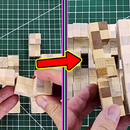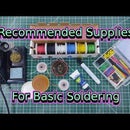Introduction: How Infinity Mirrors Work - With Experiments
While I was building my first 2 infinity mirrors I started playing around with them and I noticed some interesting effects. Today I'll be explaining how infinity mirrors work. I will also be going over some of the effects that can be made with them.
If you would like to see a video version of this instructable, you can view that here: https://youtu.be/LjWMxUitOHo
Here are some of the parts I used to prepare for this instructable:
Step 1: Basic Theory
For an infinity mirror, you'll need at least 3 things: a light source, a mirror, and a partially transparent mirror. Normally the mirror will have it's reflective surface on the outside of the glass, this would be the back of the infinity mirror. The partially transparent mirror can have it's reflective surface on the outside of the glass or the inside. Typically it will be a layer of film that it applied to it, so having it on the inside protects the film from scratches.
When the light source turns on, the light reflects between the 2 mirrors. Actually, it reflects between the reflective surfaces. It reflects back and fourth in between, but on the partially transparent side some of the light gets out. This is the lights you see from the outside. Each time light escapes from the reflections, it gets dimmer inside and the infinity effect gets fades.
Step 2: Double Sided
For my infinity mirrors I did this a little bit different. Instead of a regular and a partially transparent mirror, I used 2 partially transparent mirrors. Then when the light comes on, it still reflects off both sides, and light would escape from both sides. This allowed me to have the 2-sided effect that I was trying to get.
Step 3: Can I Use Just One Piece of Glass?
This got me thinking. If I need a light and 2 reflective surfaces, what if both of the reflective surfaces were on one piece of glass? When the light turns on, some of that light should pass through the first surface then reflect between both surfaces. Obviously, some of the light will reflect away first, but the light that does pass through should result in an infinity effect. Now lets try that out and see if it actually does.
Step 4: Here's How That Worked Out
Here I have it built and when I turn it on... There is a little bit of an effect, but it's almost unnoticeable. Kind of just looks like a blur. After thinking about why it's like this, I realized that there are 2 causes of this issue. First, most of the light is reflecting away from the back. Next is the thickness of the glass. It's only 2 mm thick, so there isn't much of a distance to separate the reflections.
Step 5: Experiments - 2 Partial Mirrors
Next let's see what a few changes can make. Here I have my 2-sided infinity mirror from 2 different angles. You can see how the reflections look using 2 partial mirrors.
Step 6: Experiments - 1 Partial Mirror and a Regular Mirror
Let's replace that back panel for a regular mirror to see the difference it makes. The effect is much better. It's brighter, more clear, and it goes deeper.
Step 7: Experiments - 2 Partial Mirrors and a Regular Mirror + Movements
Now for the cool part, adding the partial mirror back in, but leaving the normal mirror too. It looks a bit blurry, but if I lift the 2-sided infinity mirror away from the normal mirror, it stretches it out. I can even move it around and make the tunnel appear to turn and curve. Even without the back partial mirror I can get a stretching effect when lifting it, but I like that effect better with both partial mirrors in place.
Step 8: Bending the Front Plastic Partial Mirror
And since I used plastic for my partial mirror on the front, I can bend the plastic with a little pressure to warp the tunnel. But DO NOT try to bend and warp glass like this!
Step 9: And That's It! (Almost)
That's all for now. I'm still going to explore more options. If you have any ideas or suggestions, please leave a comment and let me know. I would love to hear them.
EDIT:
I have tried some more ideas, and added a few more steps to this instructable.
Step 10: Update!
After I built my Infinity Play Button, I tried a few different shapes of mirrors to try out the effects they give. This seemed like the perfect opportunity since it's a small mirror and easier to try out. With the pictures shown in this step, I used a regular flat mirror. As you can see from the side view picture, the LEDs look like they are going straight in. The picture that is more of a straight on view, you see the effect as expected.
Step 11: Concave Mirror
When I used a concave mirror (shaped like a bowl) you can see that the effect is quite different. This mirror isn't very concave, but you can still see that the LEDs look like they are bending out, away from the center. This is much easier to see when viewing at an angle. While viewing it more straight on, the infinity effect look like it doesn't go in as far as you see with a flat mirror.
The mirror I used here is a 2-sided, magnifying mirror
Step 12: Convex Mirror
When using a convex mirror (shaped like a bubble) the effect is much more noticeable. Whether you're viewing it straight on or at an angle, the effect is pretty much the same. The LEDs look like they are going in toward the center.
The mirror that I used here is a blind spot mirror for a vehicle.
Step 13: Summary
What I've realized with ALL of the experiments that I've done, if the reflective surface that you're using, whether on the front of the infinity mirror or the back, bends toward the LEDs, you get an effect that converges toward the center. If the reflective surface bends away from the LEDs, the effect diverges away from the center.
I hope this info helps with your projects! Here is a link to the video I made with these new experiments: https://youtu.be/nT3SuE0uSf8





